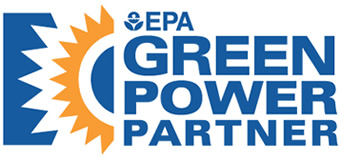Key Programs and Incentives
Benefits For You
Key Programs and Incentives
Benefits For You

Green Power Partnership
This voluntary program encourages organizations, including homeowners, to purchase
green power. Remember, there is no cost to join the Green Power Partnership!
Green power is electricity generated from renewable sources like
solar, wind, and
geothermal.
Here are some of the benefits of joining the Green Power Partnership:
- Using green power reduces greenhouse gas emissions and other air pollutants
- Green power helps combat climate change by reducing the use of fossil fuels
- Green power helps in improving air quality and public health
- Joining the Green Power Partnership shows that you are committed to
environmental
responsibility

Consumption
Tax
Credits:
Another Incentive!
These credits are awarded directly to consumers who purchase green power, reducing their
tax
liability.
Credit amount: The amount of credit varies significantly from state to state. Some
states
offer a fixed credit per kWh of green power purchased, while others provide a
percentage-based
credit.
Eligibility: Eligibility
requirements also
vary.
Some
states offer credits to any consumer who
purchases green power, while others have specific requirements, such as the type of
renewable
energy source or the size of the energy system.
Claiming the credit: The process
for
claiming
the
credit also differs. You may need to submit a
separate form with your tax return or apply for the credit through a specific program.

Combined Heat and Power Partnership:
CoGeneration!
Combined Heat and Power
(CHP),
or cogeneration, is an efficient technology that utilizes a single
fuel source to generate electricity and heat.
Benefits of CHP Systems:
- CHP systems convert up to 90% of the fuel's energy into usable energy, significantly
reducing energy waste compared to conventional power plants
- They generate both electricity and heat on-site, resulting in lower energy costs
- CHP systems produce fewer greenhouse gas emissions when compared to fossil fuels
- On-site generation can provide backup power during outages
- CHP systems create more jobs in manufacturing, installation, and maintenance
Available CHP Systems for Homeowners:
Micro-CHP Systems: These smaller, more affordable systems are
specifically designed for
residential use. Typically fueled by natural gas, they can generate up to 5 kW of
electricity
and provide heating and hot water. Micro-CHP systems usually cost between $15,000 and
$25,000
to install, including equipment and labor.
Packaged CHP Systems: These pre-configured systems offer a
convenient and streamlined
installation process but may be less customizable. These systems can cost upwards of $30,000
to install.
Maintenance Requirements: Regular maintenance, which ranges
from $500 to $1,000 per year,
is necessary to ensure optimal performance and efficiency.
Availability and Pricing: Fuel Type
Natural gas: the most common and
typically cheapest fuel
source, but prices fluctuate depending on location and supply.
Propane: a more expensive
alternative
than natural gas,
but
more readily available in some areas.
Biogas: renewable fuel
source that
can be produced from
organic waste but may require specific infrastructure and processing.
Environmental Regulations:
Compliance with local
environmental regulations is required for CHP installation and operation.
- A homeowner with a 5 kW micro-CHP system using natural gas and saving 25% on their
energy
bills
might see an annual payback period of around 7-10 years.
- A homeowner with a larger 10 kW system and higher energy consumption might see a
faster
payback
period of around 5-7 years.

Availability and Pricing: Fuel Type
Natural gas: the most common and typically cheapest fuel source, but prices fluctuate depending on location and supply.
Propane: a more expensive alternative than natural gas, but more readily available in some areas.
Biogas: renewable fuel source that can be produced from organic waste but may require specific infrastructure and processing.
Environmental Regulations: Compliance with local environmental regulations is required for CHP installation and operation.
- A homeowner with a 5 kW micro-CHP system using natural gas and saving 25% on their energy bills might see an annual payback period of around 7-10 years.
- A homeowner with a larger 10 kW system and higher energy consumption might see a faster payback period of around 5-7 years.

Residential Clean Energy
Credit:
The amount of the credit you can take is a percentage of the total improvement
expenses in
the
year of installation:
- 2022 - 2032: 30%, no annual
maximum or lifetime limit
- 2033: 26%, no annual
maximum or lifetime limit
- 2034: 22%, no annual
maximum or lifetime limit
The credit is nonrefundable, so the credit amount you receive can not exceed the
amount you
owe in
tax.
You can carry forward any excess unused credit and apply it to reduce the
tax you
owe
in future years.
The credit has no annual or lifetime dollar limit except for credit limits for fuel
cell
property.
Fuel cell property: The credit amount for fuel cell property is
limited to $500 for
each
half
kilowatt of capacity of the property.
If more than one person lives in that house, the combined credit for all residents
can not
exceed
1,667$ for each kilowatt of fuel cell capacity.
Eligibility: You
can claim this credit for any new or existing home in the United States.
You can only claim this credit if the house is not rented or is your residence.
You must live at least part-time.
You can only claim this credit if the house is not rented or is your residence.
You must live at least part-time.

Qualified Expenses:
1. Solar electric panels
2. Solar water heaters - must be qualified by a solar rating certification
corporation or a
comparable entity endorsed by your state.
3. Wind turbines
4. Geothermal heat pumps - must meet Energy Star requirements.
5. Fuel cells
6. Battery storage technology (beginning in 2023)-must have a capacity of at least 3
kilowatt
hours.
7. Qualified expenses include labor costs for onsite preparation, assembly, or
original
property installation and piping or wiring to connect it to the home.
You may need to subtract rebates or other financial
incentives
from your qualified property expenses when calculating your credit.


Energy Efficient Home Improvement Credit
These expenses may qualify with some requirements:
- Exterior doors, windows, skylights, and insulation materials
- Central air conditioners, water heaters, furnaces, boilers, and heat pumps
- Biomass stoves and boilers
- Home energy audits
The amount of the credit you can take is a percentage of the total
improvement
expenses in
the
year of installation:
- 2022: 30%, up to a lifetime maximum of $500
- 2023 through 2032: 30%, up to a maximum of $1,200 (heat pumps, biomass stoves, and
boilers
have
a separate annual credit limit of $2,000), with a lifetime limit.
Eligibility for this is the same as residential clean
energy credit.

The Inflation Reduction Act of 2022
provides funding, incentives, and programs to speed up the transition to a clean energy economy.
Rooftop Solar
The Inflation Reduction Act will help more Americans harness the sun's energy to power their
homes with clean energy and save big on utility bills. FederalTax credits are available to cover
up to 30% of the installation costs which can be paired with additional state-specific
incentives. The average family will save 300$ per year or 9000$ over the system's lifetime.
Insulation and Air Sealing
The Inflation Reduction Act provides tax credits and rebates for a range of home improvements
that reduce energy leakages like insulation material, which can lower heating and cooling costs
by up to 20% or save money on utility bills.
Clothes Dryer
The Inflation Reduction Act provides rebates that can cover up to 100% of the costs of
purchasing and installing a new electric heat pump dryer as they are more efficient than
conventional electric dryers and gas dryers in saving money on the electric bill with each load.
Electric Stove or Oven
The Inflation Reduction Act provides rebates that can cover up to 100% of the cost of electric
stoves, cooktops, ranges, and ovens depending on household eligibility as they are more energy
efficient than gas stoves helping families save money and keep unhealthy pollution out of their
homes.
Weatherized Windows and Doors
Windows can be responsible for 25-30% of heating and cooling energy use, and doors can leak
significant amounts of energy as well. The Inflation Reduction Act supports the upgrades of
these exterior windows and doors along with home energy audits.
Electric Vehicle
The Inflation Reduction Act gives tax credits of up to 7000$ for new electric vehicles and 4000$
for used electric vehicles saving families an average 950$ a year on fuel costs.
Heat Pump Water Heater
The Inflation Reduction Act includes tax credits and rebates that can cover up to 100% cost,
depending on household eligibility for installing a heat pump water heater that is two to three
times more energy efficient than conventional water heaters.
Want to learn about your specific state?
Check out
the
website DSIRE!
For more information go to whitehouse.gov!
Summary of Incentives

